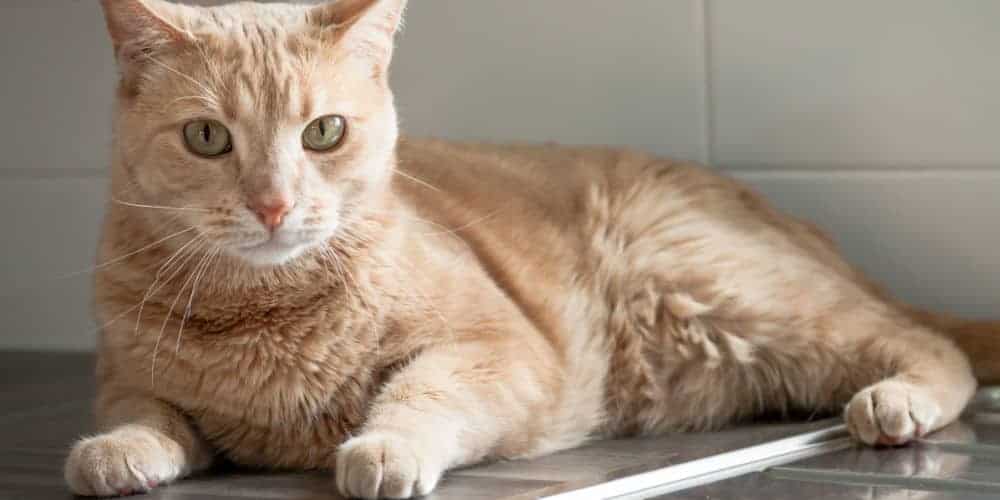How to Keep Cats off Counters: 8 Methods to Try

You’re kneading pizza dough on your kitchen counter. Your cat, the adorable angel that he is, decides to help you out by joining you with the task.
You try to shoo him away but he’s not deterred, determined to imprint his unsanitary paws on your dough despite your pleas and thinly veiled threats.
Unfortunately for you (but fortunately for him), he succeeds. You then think to yourself, how can I keep my cat off my counters?
Over the years, I’ve struggled to keep my cat off my counters, furniture, and other “no-walk” surfaces. I’ve tried a bunch of stuff, but nothing seems to work. Until today, that is!
If your cat is as much of a countertop hopper as mine, stick around. I’m here to guide you on how to keep cats off counters once and for all.
Cat Attitudes is reader-supported. When you buy through links on our site, we may earn an affiliate commission.
Why Does My Cat Keep Jumping on My Counter?
It’s common knowledge that cats love climbing and jumping to/from high places. It’s in their DNA; a natural expression of their feline intuitions. Animal behavior experts believe this stems from their hard-coded instincts to protect themselves. The higher they are, the safer they’ll be.
Kitchen counters are a whole different story. While cat owners shouldn’t disregard this behavior as self-preservation, most cats jump on top of counters just because they can.
Counters are cool, clean, and smell nice. They’re filled with treasures, too; loaded with tempting treats like thawing ground beef, half-eaten chicken, or yesterday’s marinated tuna steak.
Moreover, cats are attracted to running water. If your kitchen counter is attached to a sink, they’re more likely to hop on your counter to take several sips of running water.
Finally, some cats simply like watching you while you’re chopping and sautéing. What better way to do that than on top of a kitchen counter?
Is Countertop Hopping Really That Bad?
Cats who regularly counter surf aren’t only a mild inconvenience. It’s actually unsafe for both cats and human owners, so countertop hopping should always be discouraged.
When cats walk on kitchen counters, cat owners expose themselves to bacteria. Cats use their paws to cover their litter box business, so their paws are super unsanitary. If bacteria goes into your food, this poses a major sanitation concern that shouldn’t be ignored. The transmission of toxoplasmosis (a one-celled parasite found in cat feces) isn’t a joke!
Counter hopping can potentially be dangerous to cats, too. For instance, cats who regularly jump up a kitchen counter may accidentally hurt themselves by jumping on a sharp object or landing on a hot stove. They might also expose themselves to recently used chemical cleaning products and ingest food unsafe for cat consumption.
How to Keep Cats off Counters and Tables
Throughout the years, there are several techniques I followed to keep my cats off my counters. Every cat is different, so if one method fails, try another!
Method 1: Apply Sticky Tape Onto Your Counter
The sticky tape method is often used to keep cats (and dogs) off or out of unwanted areas.
Simply apply a line of sticky tape on the edges of your counter and wait until they jump on the surface. Once their paws touch the tape you’ve placed on the edge of the counter, they’ll quickly learn that the countertop is a no-no zone.
Cats find the sensation of sticky things quite unpleasant, so there’s a high chance that they’ll stop jumping on the surface after two or three tries.
The only disadvantage is that you’ll likely have to frequently reapply the tape when it loses its stickiness. Cats may also outsmart you and avoid the sticky surfaces by jumping right above them!
Method 2: Use Aluminum Foil
Most cats dislike the feel of aluminum underneath their paws. They likewise find the crinkly noise uncomfortably loud!
Take several strips of aluminum and stick them onto the surface of your countertops. You can also use cookie sheets if you don’t have foil available. For best results, cover most of the countertop’s surface.
Once your cat realizes the aluminum is there to stay, he may stop counter hopping!
The aluminum foil method, while effective, might disrupt the way you use your counter space for a couple of days. It may also be quite wasteful!
If this method doesn’t work on your cat for the first week, it’s best to search for another technique.
Method 3: Try Scent Deterrents
If the aluminum foil or the sticky tape method doesn’t work, it’s time to bring out the big guns: scent deterrents.
Cats have a surprisingly picky nose. They dislike the scent of anything overly powerful.
Scent deterrents, or cat repellents, are non-toxic formulas that keep the cats away from surfaces and furniture.
Most of these products are 100% natural, so you can safely apply them to your countertops without worrying about your cat’s health. They smell pretty good, too—at least to us humans!
You can find scent deterrents in pet stores or online. You can also make one yourself by mixing apple cider vinegar and water at a 1:1 ratio or use essential oil and water at a 1:3 ratio.
Here are essential oils and scents that cats dislike the smell of:
- Lavender
- Citrus (orange, lemongrass, etc)
- Peppermint
- Cayenne pepper
- Rue
- Pennyroyal
- Citronella
- Cinnamon
- Vanilla
Use this mixture as a “booby trap” deterrent by spraying it on your counter. If that doesn’t work, spray the mixture in your cat’s general direction whenever you catch him on top of your counter.
Don’t use the deterrent as a punishment; you don’t want your cat to fear you! Instead, use it as a tool to keep them off your counter. This is why you shouldn’t directly spray the deterrent onto your cat’s face.
Method 4: Remove All Temptations
Keep your counters sparklingly clean and wipe away crumbs and spills as soon as they happen. Don’t leave fruit, bread, meat, or any other type of food on your counter.
If your cat realizes there are no goodies waiting for him to feast on, he might not find the counter so tempting anymore and stop jumping on it.
Unfortunately, this method may not work if your cat jumps on your counter regardless if there’s food or not. But if he’s a snack bandit, it’s definitely something you should try!
Method 5: Remove the Chair
Ask yourself this: what does my cat use to get on my counters?
Figure out how your cat manages to jump on your counter and eliminate the boost. It could be a chair, a table, or even your trash bin. He can’t jump on your counter if it’s too far out of his reach!
Method 6: Invest In a Cat Tree
Cats love being in high places. Their instinctual need to observe the world from a high vantage point outweighs the dangers that come from being perched so high.
As a cat owner, it’s your responsibility to provide your feline with plenty of opportunities to explore and climb in your house. Maybe your cat keeps climbing your kitchen counter because he doesn’t have any other place to jump in or because it’s the only high area that’s accessible to him.
If your cat doesn’t have a cat tree, it’s time to invest in one. Make it high and interesting enough to hold your cat’s attention. You can also make it more tempting by hiding a tasty treat in one of the cubicles or placing a cat toy on top of the tree.
Every time your cat uses his tree, praise him and pet him to encourage him to use it more frequently.
Method 7: Use a Scat Mat or an Electric Shock Mat
Scat mats might look a bit scary with all their pointy nubs, but it’s actually completely safe for cats! The nubs are soft, non-toxic, and painless.
Scat mats are a great way to inform your cat that your counter is strictly off-limits. While not painful, the nubs are quite uncomfortable. Once your cat realizes that the annoying surface is there to stay, he’ll surely stop jumping on your counter.
Place the scat mat on your counter whenever you’re not using it. Unlike the sticky tape and aluminum foil method, you don’t have to constantly replace the mat whenever your cat jumps on it! Once you’re done using it, simply roll it away for storage.
If you don’t have a scat mat, make one yourself using a clear plastic runner with nubs. Cut it to your desired size and stick it to your kitchen counter with tape.
Alternatively, you can buy an electric shock mat. I know what you’re thinking—that sounds cruel! I thought so myself at first, but don’t worry; just like scat mats, shock mats are super safe. The voltage in these things is extremely low. Touching the mat with your hand will just give you a sort of static sensation that doesn’t hurt at all.
Electronic mats come with a controller so you can adjust the setting as desired. They’re also equipped with a small alarm that rings whenever your cat steps on the mat.
Method 8: Hang Towels off the Edge of Your Counters
If you have a lot of towels, this method is for you. Hang several towels off the edge of your countertops. When your cat attempts to jump on your counter, the towel will slide right off!
This method won’t work if you have a persistent cat, as he may try to jump on your counter a second time without the towel protecting it.
The same is said if your cat is a countertop hopper extraordinaire; he may also jump over the towel and not trigger the “trap” you’ve set for him. Still, it’s worth a shot!
Final Thoughts
Counters are like cat magnets; cats just can’t seem to resist them! Many cat owners think it’s OK to let their cats counter-surf. However, counter-surfing is dangerous to both cats and their human owners.
For the safety of your pet and your family, keep your pet feline off your countertops as much as possible.
With the methods above, your cat will hopefully stop hopping on your counters once and for all. Good luck!
